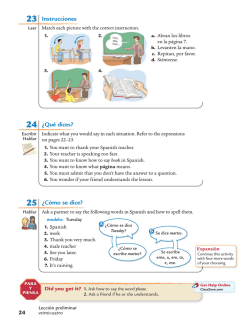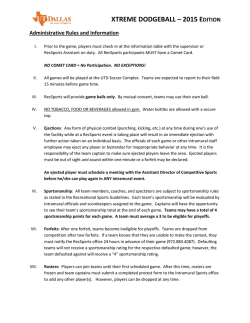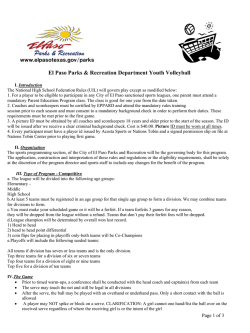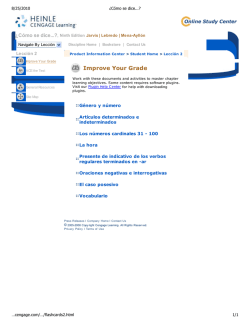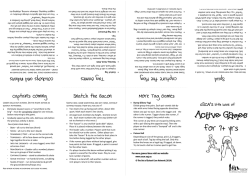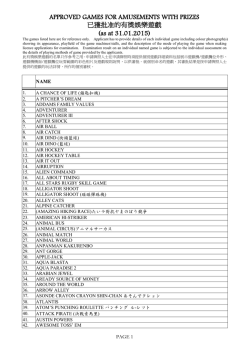
DreadBall Xtreme Example Rush
Dreadball xtreme: GETTING STARTED PLaying your first game I’m sure you’ll be keen to dive straight into your first game. The fastest way to do this is to have a friend show you how to play. However, if this isn’t convenient then don’t worry. The following section provides a narrative and simple demonstration of DreadBall Xtreme in action. You are encouraged to set the board up in accordance with the diagram and follow along, moving the models yourself as the game progresses. Each part of the game will provide a reference to the main rules, so that once you’ve got the hang of each part of the game you can learn how to play it in full. Dice Tests Most dice tests in DreadBall Xtreme involve a target number (based on the individual players’ characteristics) and a number of dice to roll. Each dice that rolls equal to or over the target number counts as a ‘success’ and the number of successes determines the result of the test. In this scenario, you are provided these details as the game is played out. First, you are provided the target number, then the number of dice to be rolled. Many tests in Dreadball Xtreme also utilise a mechanic called ‘rolling up’. Where this is the case, dice rolls of 6 will result in a success, but also allow you to roll another dice and add it to the test results. Similarly, if additional dice also roll a 6, they will continue to add bonus dice. An example of this is provided within the scenario. As you are stepping through this self-paced demonstration, the results of each roll will be provided to you so you can play along. Those results which count as a success will be displayed in bold to better demonstrate what is going on and the in-game effects of the result will be described to you. An Xtreme Example This demonstration represents the closing minutes of a game where the Home Team Convicts have just scored to equalise. Set the score marker at ‘0’ and the Rush counter at ‘11’. In DreadBall Xtreme, each team activates their players in a game period called a Rush. A team has four actions to play before their Rush ends (unless the Rush is ended prematurely – see page 40) and play passes to the other team. S ! CJ KS CT S KS ! CJ ! KJ S 10 S S To play out this scenario, you will need two Kalyshi Strikers (marked KS) and one Kalyshi Jack (KJ) for the Pirate Team. For the Convict Team you will need two Convict Jacks (CJ) and one Convict Thug (CT). Additionally, you will need four strike posts (marked !) and four trap crates (marked S). The diagram shows where to place these models at the start of the demonstration. The triangles show the initial facings of the players. ! At the start of the new Rush, the Rush counter is advanced one space – in this case to 12. As the Convicts have just scored, a new ball must be launched (the full rules for ball launch are on page 29), and it is the Pirates’ turn to act. There are 6 potential ‘chutes’ from which the ball can launch. These are represented by the numbers 1 to 6 around the central area of the pitch. These numbers also provide a reference point for randomising direction with a single dice roll. The full rules for randomising direction are on page 29. A. The Coach (that’s you, the human playing the game) of the Pirate team rolls one dice to determine which chute the ball launches from, one dice to determine the direction of scatter and one dice to determine the distance that the ball scatters. He rolls a 4, 5, and 4 causing the ball to launch from chute 4, and scatter in direction 5 for four spaces. B C. Having retrieved the ball, the Kalyshi now wants to get into a position to make a successful strike. Strikes can be made from the 6 coloured areas of the pitch – the Home team must score in the blue Away Strike Zones, and the Away team score in the yellow Home Strike Zones. A player must be within this area and then throw the ball at the Strike Post to score. A B. Eager to recover the ball, the Pirate coach plays his first action token on player ‘A’ to declare a Run action (the full rules for Running are on page 32). Player ‘A’ can move up to six spaces, and decides to move onto the ball. During a Run action, a player can move in any direction and face in any direction. In this case, Player ‘A’ opts to end the Run facing directly back in the direction she had moved from. Dreadball xtreme: GETTING STARTED RUSH 12 (THE PIRATES) With both strike zones too far away to run to, the coach plays a second action token and declares a Sprint action (the full rules for Sprinting are on page 32). Sprinting sacrifices the ability to turn easily for the benefit of straight-line speed. The Kalyshi can move twelve spaces (twice her Move distance) when Sprinting, but must move into the hex directly in front of her. Each turn the player makes costs one space of movement. Player ‘A’ moves along the path shown in the diagram to get into a position to score. When Player ‘A’ reaches the ball, her Run action immediately ends and she must attempt to Pick up the Ball (the full rules for picking up the ball are on page 39). Player ‘A’ is a Kalyshi Striker – a proficient ball handler - and has a target number of 4+ on four dice when attempting to pick up a ball. Any dice that result in a 4+ will count as a success. The Kalyshi rolls a 2, 2, 3 and 4 meaning she has rolled one success and manages to pick up the ball. C 11 Dreadball xtreme: GETTING STARTED D. In a Rush, each player can only have two actions spent on them. As the Kalyshi ‘A’ has used her two actions for this Rush she is unable to attempt to strike. The pirate coach uses his third action to Run in Player ‘B’ and protect the ball carrier. Player ‘C’ uses the fourth action to run into a position to harass the nearest Convict Jack (Player ‘Y’). D RUSH 13 (THE CONVICTS) The Convict coach advances the Rush counter to Rush 13. E. With the end of the match rapidly approaching, the Convicts need to get more points on the scoreboard if they hope to win, but first they need to get the ball back. The Convict coach declares his first action on player ‘X’ as a Slam (the full rules for a Slam are on page 34). Player ‘X’ is a Convict Thug, a tough brute of a player who gets a free Run action before attempting to Slam his opponent. The Thug Runs his maximum of five spaces to a position adjacent to the Kalyshi carrying the ball, being careful to avoid the other pirate player providing support. In a Slam, the Thug requires 3+ on five dice. The Kalyshi Striker responds to the Slam by declaring a Dodge – needing 3+ on four dice. The Convict Thug rolls a 2, 2, 3, 4 and 5 (three successes) and the Kalyshi rolls a 1, 1, 3 and 4 (two successes). In comparing the results, the Thug has performed well enough to push the Kalyshi player into one of the spaces behind her and chooses direction 1. Having pushed his opponent back, the Thug has the option to then move into the space vacated by the Slam target, but chooses not to. F. Whilst the previous slam was successful in pushing the Kalyshi, it hasn’t helped to dislodge the ball from her hands. The Convict coach commits his second action for another attempt to Slam. This time the Thug uses his free Run to move the one space to get next to the ball carrier and rolls 3, 3, 4, 6 and 6. The two 6s ‘roll up’ allowing him to roll another two dice and add them to his result. He rolls a 3 and 5 giving him a huge total of seven successes. In response the Kalyshi again tries to Dodge. The Kalyshi Striker rolls a 1, 2, 3 and 5 giving her a total of two successes. The Thug has Slammed his opponent hard enough to push her back, and knock her down. The Kalyshi is pushed back in direction 1 and this time the Thug chooses to follow up into the vacated space. F E 12 The ferocity of the attack means that it is possible that the Kalyshi may also have been seriously hurt. Her two successes are subtracted from the Grogan’s seven, leaving five injuries for the Kalyshi to try and save with her armour (the full rules for armour tests are on page 35). The Kalyshi needs 5+ on three dice and rolls 4, 5 and 5, saving two of the five injuries. The remaining three injuries are represented by injury markers placed next to the prone model. She will not be taking any active part in the match until she recovers (the rules for recovery tests are on page 35). The convict’s action ends when he lands on the ball and he attempts to pick it up needing 5+ on two dice. He rolls a 5 and a 5 scoring two successes. Scoring two or more successes when picking up the ball represents the player collecting the ball exceptionally well. It grants the player a free Run or Throw action which doesn’t count toward the player’s two action maximum. The Convict Jack uses his free action to Run back in the direction of the scoring zone. I. His path causes him to need to evade again, rolling 2 and 4, successfully slipping past his opponent. G H. Keen to capitalise on the scattered ball, Player ‘Z’ moves for the ball. Player ‘Z’ is a Convict Jack who needs to Sprint in order to have enough movement to get to the ball and uses the Convicts’ third action to do so. He has a Move value of 5 and can therefore Sprint 10 spaces. As he passes close to Player B, he has to Evade to get past without tripping (the full rules for Evading are on page 38). Our Convict Jack needs 4+ on two dice. He rolls a 3 and 4, nimbly slipping past his opponent. H The Convict Jack needs to get a little closer to the strike zone if he hopes to score this Rush. His movement can be extended by the use of a Dash (the full rules for Dashing are on page 38), which allows a player to extend their normal Run or Sprint action. However, a Dash is a risky manoeuvre and a failed attempt would see him trip and fall. To Dash successfully, the Convict Jack needs 4+ on three dice. He rolls a 2, 2 and 4 gaining the one success necessary to Dash without falling over. Feeling a little bit cocky with his luck so far, the Convict decides to Dash a second time. Each consecutive attempt to Dash gets a little harder and for the second attempt he will need two successes. He again needs a 4+ on three dice. He rolls a 2, 4 and 5. He gets the two successes he needs and successfully advances to the second extra space. I Dreadball xtreme: GETTING STARTED G. As the injured Kalyshi was carrying the ball, she drops it when she is knocked down and the ball will scatter from the space she was knocked into (the full rules for a scattering ball are on page 29). The Convict coach rolls one dice for direction and then one dice for distance. Rolling a 6 and 2, the ball is moved in direction six, two spaces. 13 Dreadball xtreme: GETTING STARTED J. The convict Jack wants to use the fourth action to score a strike, but is one space away from the score area. As a Jack, he is able to step one space before attempting to throw the ball. The player moves adjacent to the strike post and makes his Dunk (the full rules for a Dunk are on page 36). A Dunk is only worth one point, but is the easiest of strike attempts. It occurs automatically and does not require any dice roll to succeed. The convict coach moves the score track one point in his favour and his Rush ends. J RUSH 14 (Pirates) The Pirate Coach moves the Rush token to Rush 14 and relaunches the ball, rolling a 3, 5, 1. The ball launches from chute 3, and rolls toward direction 5 for one space. K. Seizing an opportunity to hurt the Thug, Player ‘B’ declares a Slam with action one. Player ‘B’ is a Kalyshi Jack and is allowed to move one space before applying the Slam. In this case the Kalyshi Jack is able to Slam the Thug in the back needing 5+ on four dice. He rolls a 2, 5, 5 and 5. Normally, the Thug would be an intimidating target to attack, but because the Kalyshi Jack has Slammed him from behind, the only available response is to Dodge. The Thug attempts to Dodge needing 4+ on three dice and rolls 2, 4, 5. The Pirate Player pushes the Thug away but has not done enough damage to hurt him. The Pirate coach notices however that there is a trap nearby and decides to push the Thug player into it. 14 K L. When a player is moved next to a trap, there is a chance that it may explode (the rules for traps are on page 26). When a player is moved adjacent to a trap, the lid is removed to display the size of the resulting explosion. In this case, the trap explodes applying the effects of a five-dice Slam to the Thug. The Pirate coach tries to roll 4+ on four dice, rolling 4, 4, 5, 6. The 6 is rolled up and adds another success with a 5. The Thug can only Dodge and needs 4+ on 3 dice and rolls a 2, 3 and 5. The explosion would push the Thug into the space directly away, but because Kalyshi ‘A’ is in the way the Thug is knocked down in the space he is in. The Thug’s one success leaves him with four injuries for his armour to save. Needing 4+ on three dice, the Convict coach rolls a 1, 2 and 3 and gets no successes. With four unsaved injuries – enough to kill him – the Thug is removed from the pitch. L Because the Kalyshi is a Striker, she can make a free Run action before commencing a Throw. A one point Dunk will be insufficient to win the game, so she runs into a space in the strike zone further from the strike post (the full rules for Throwing a strike are on page 36). With the game result now resting on this final roll, she needs a 4+ on two dice and rolls a 3 and 4. She scores the two point strike, moves the score token two points back in the Pirates’ favour and wins the game! M N. It is the last Rush of the game, and the Pirate coach realises that he needs to score two points to win the match. Player ‘C’ uses action three to declare a Throw. N Dreadball xtreme: GETTING STARTED M. Player ‘C’ is also a Kalyshi Striker and uses action two to Run and collect the ball, moving up to six spaces and needing 4+ on four dice. She rolls a 2, 3, 3 and 4, picking up the ball but not generating a free action. Now that you have seen the basic actions available to DreadBall Xtreme coaches, why not reset the scenario and try playing it out yourself? Roll each test yourself and see if the Convicts can thwart the plans of the Pirate team. If you roll a different result, check the main rules for that test and see what happens instead. On a second play through, you might mix up the actions and play out the game differently. Referencing each of the relevant rules sections, decide for yourself when to run and collect the ball, or when it might be better to slam the opponent. Actually roll the dice to launch the ball and consider the benefits of a Run or Sprint action as needed. Decide when each is most appropriate and keep an eye out for those traps. Once you’ve gotten a firm grasp of how DreadBall Xtreme plays you are ready to take those skills to the street. But remember, on the streets, matches include hidden weapons, unhinged sponsors and the jeering of the angry mob. Have fun – but watch your back! 15
© Copyright 2025
